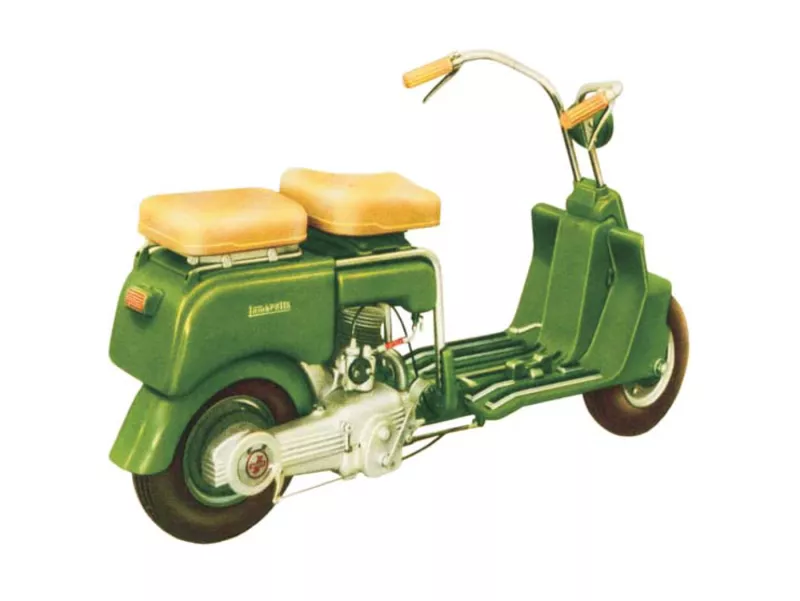very good
4.7 / 5
Shipping today with order in 19 min
Postage free from 99€ (DE)
High customer satisfaction
Shipping today with order in 19 min

Lambretta m (A) 125
Lambretta 125 m (A), the scooter that started it all at Innocenti, was manufactured in Milan from October 1947. By October 1948, 9669 units had been produced. In general, the 125 A was a reasonably priced and, for its time, very fast scooter with a top speed of almost 65 km/h and low fuel consumption. The body is radically simple and basically consists of two main sections. The front section consists of a pressed square tube with the steering head and fork at the front end, while the rear section consists of two bent chrome tubes that surround the tank and end in the large luggage compartment.
The engine is a wind-cooled 123 cc engine with cardan drive. The 3-speed gearbox is shifted by foot via a linkage. This foot-operated gearshift can only be found on A-series vehicles. The suspension of the 125 A is very limited. It has two simple springs at the front and is simply non-existent at the rear or is limited to the air cushion in the 7-inch tires. The beautiful, clear and clean appearance of the A is due to the fact that all cables and wires run inside the pipes. However, these internally routed cables are a not insignificant disadvantage if a cable needs to be replaced. This is only possible with considerable effort.
A very interesting little gimmick, which is unfortunately only to be found on the A, is the standard metal oil measuring cup, which is embedded in the green plastic tank cap. From today's perspective, Innocenti took a rather unusual approach here, with the brake shoes made entirely of steel and the brake lining firmly embedded in the drums.
Innocenti continued to develop its model, so that today we know three series of the 125 A. During these years, Innocenti made use of surplus paint, as it had been produced in large quantities for military purposes in earlier years. In comparison, Innocenti was thus able to offer a wide range of six different colors.
125 m (A) - 1st version
(up to frame number ~ 6900)
The front seat is square and light brown, the pillion saddle was only offered as an accessory and was generally covered in black.
The luggage compartment is fitted with a proper lock, which also functions as an ignition lock.
It has chrome-plated rims as standard. The rims are bolted directly to the brake drum with three chrome-plated nuts.
The horn is operated mechanically with the foot.
The fan wheel cover of the first models is painted in the vehicle color.
The gearshift pedal is straight. The brake pedal is located on the right-hand side at the rear (i.e. on the same side as the gearshift pedal).
The main stand has no spring, but must be hooked onto a small lever after jacking off.
125 m (A) - 2nd version
(up to frame number ~ 11000)
The front saddle now has the classic triangular shape and has barrel springs for suspension. Compared to the 3rd version, the saddle is significantly smaller and has a beige saddle cover. The pillion saddle was an accessory and also had a beige cover.
The lock on the luggage compartment has now been replaced by a simple lever.
The mechanical horn has been replaced by a 6V buzzer. A kill switch is now located where the lever for the mechanical horn used to be.
The rims are no longer chrome-plated but painted silver. The rear rim now has separate rim nuts.
The shift pedal is no longer straight, but slightly angled.
From frame number 10,000, the brake pedal is moved to the rear left-hand side.
125 m (A) - 3rd version
(up to frame number ~ 14700)
As with the last 10.00 vehicles in the second series, the brake pedal is on the left-hand side.
The suspension of the driver's seat is now a central, horizontal spring, and the cover is brown.
The main stand, welded together from several individual parts from the 3rd series onwards, is made of gray cast iron and has a spring.



